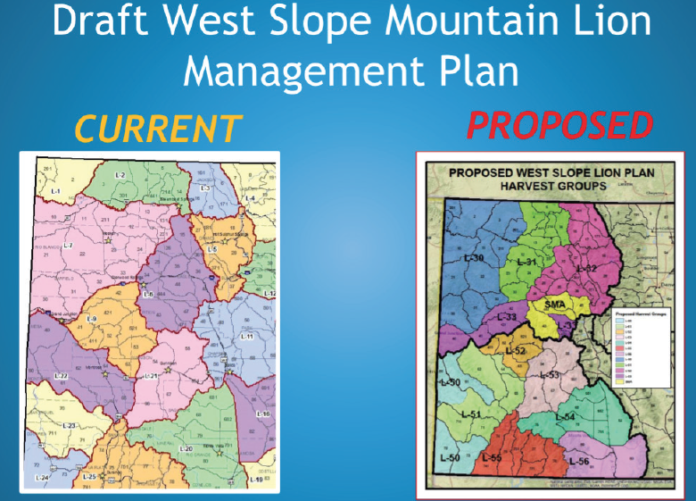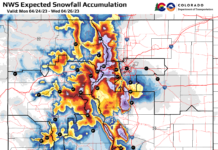by Marissa Lorenz
Colorado Parks and Wildlife (CPW) welcomed nearly 30 members of the public to an informational meeting this week at the CSU Extension Hall in Kremmling. The meeting presented a draft proposal for a West Slope Mountain Lion Management plan that would, if successful, go into effect in April 2021.
The presentation included a slide-show demonstration, offering attendees maps of the current and proposed lion harvest areas; historical data, including statistics for harvest limits versus actual lion harvest over the last 10-years; the wildlife science and biological motivations for the proposed management changes; and an outline of the proposed management strategy, including harvest goals and thresholds for female lions in particular.
Lyle Sidener, Area Wildlife Manager with the CPW in Hot Sulphur Springs, states that the overall changes are meant to take into consideration the newest science and data and manage lions on a larger geographical scale than has previously been done.
At present, lion harvest areas are divided into 13 regions in Colorado’s Western Slope, also known as Data Analysis Units (DAUs). These DAUs have traditionally been defined and managed as have other large game, such as deer and elk, taking as a base assumption that the species in question “can find everything they need within the area and have limited ingress and egress,” explains Sidener. “When we apply the same parameters to lions, current research shows that they work on a much larger scale.” Thus the proposed plan recommends two DAUs for the Western Slope, a Northwest region and a Southwest region, that will be divided into smaller Harvest Limited Groups. The Northwest region would be made up of four harvest groups plus a special management area. And the Southwest region would be composed of seven harvest groups.
If approved, a Resource Selection Function (RSF) model would be applied to each of the two regions in order to estimate the mountain lion population– assessing parameters such as historic habitat and resource usage, lion-caused mortality within the state’s five intensive mule deer monitoring areas, and thousands of lion habitat use location research points across the state– and determine the Harvest Limit Objective numbers (allowable lion harvests) and harvest thresholds, given age and sex, for each region. These numbers will be divided between the harvest limit areas.
Historically, there has been a gap in both regions between the given harvest limit and the actual harvest, with the harvest consistently falling below harvest limits set for species health and safety. In response to audience questioning, Sidener explains that, while there are DAUs that are eventually closed each year, due to maximum harvest being reached, there are other areas where those limits always go unfulfilled. “That would be a bit of a switch under this plan,” he says. “We would reach more of what we actually want to harvest, allowing more lions to be harvested, while maintaining a healthy, stable population. We would not have that gap between harvest limits and actual harvest.”
Of particular importance to the management plan is attention to overall mortality thresholds and thresholds for adult females harvested in a single year. The plan considers recent scientific research and literature to determine these proposed thresholds of total human-caused mountain lion deaths, due to legal hunting or other activities. For overall mortality, the proposed number is “not to exceed 17 percent total human-caused mortality on a three-year average in each region.” And adult female mortality is proposed to not exceed 22 percent of any harvest in a single year. Research indicates that this is of critical significance as, when harvested females exceed 20 percent to 25 percent of the total harvest, this may indicate a negative human impact on mountain lion populations, resulting in a downward trend. Annual harvest numbers exceeding the 22 percent limit on adult females will result in a reduction of overall permitted harvest objectives the following year.
Parks and Wildlife puts in place several procedures to help to ensure that selection of prey falls within harvest objectives. Unlike other hunting licenses, mountain lion hunters are required to have a CPW education certificate, showing that they have successfully completed an online training that includes such skill boosting as age and sex identification, before being issued a license. And once a mountain lion has been harvested, the hunter must present the animal for a mandatory inspection, where preliminary assessment of age and sex is made, based on size, tooth wear, breeding status, and physical markings. Since 2009 a tooth is also taken at this point and sent away to a lab for definitive age testing, using a process similar to that of tree ring dating.
Another consideration in the proposed plan has been the recent uptick in human-lion encounters in certain areas with growing human populations. Particularly along the western I-70 mountain corridor, there were an excessive amount of sightings near residential areas and condominium complexes in the past couple of years, with a child even being attacked and badly injured. This concern has resulted in the proposed Glenwood Special Management Area.
The proposal would permit higher harvest limits in this area in order to decrease the population, without impacting the overall harvest objectives for the Northwest region. Because residences are more dense in this area, other accommodations would also be considered, such as use of electronic calls, versus the traditional method of treeing mountain lions with hounds, and the allowance of deer and elk hunters to also kill lions if they encounter them while hunting other prey. Sidener says that these methods are not normally allowed in order to allow for more accurate age and sex selection, but that the goal for this specified area is priority management for human health and safety.
Sidener also highlights the current timeline for plan approval. Additional public information meetings are scheduled across the Western Slope over the next two weeks. In mid-March the proposal will be available on the CPW website and public comment will be accepted via online form. It will be presented to the Colorado Parks and Wildlife Commission in May for approval and, if approved, will be implemented in April 2021.
To keep up to date with the West Slope Mountain Lion Management Plan proposal or to learn more about mountain lion hunting and management in Colorado, including statistics, the mountain lion certificate exam, hunting season dates and fees, visit cpw.state.co.us/thingstodo/Pages/MountainLion.aspx.










canada pharmacy https://canadianpharmaceuticalsonline.home.blog/
Thank you, Plenty of facts.